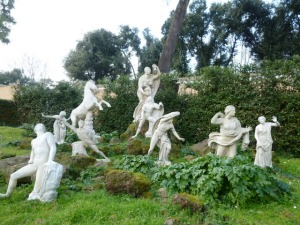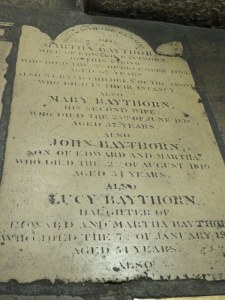I am frequently asked for ideas on what to do in Roma. After all, we have people house-and-cat-sitting all the time, often for 2 or 3 weeks. And living here, we certainly have to get beyond the usual suspects.

Embedded in the steps of the Great Hall of Galleria Colonna, this cannon ball dates back to the Risorgimento.
Everyone knows the Colosseum and Vatican, and probably the Galleria Borghese. While these should not be missed, there are many other lesser-known sights to consider. You might also enjoy reading my blog on the subject of off-the-beaten-track ideas.
Palazzi, museums, events, and exhibits
From April-November 12, 2017, there are once again special events in the Forums, a guided walk through Caesar’s Forum at night, and a multi-media show in the Forum of Augustus. You can find info at Viaggio nei fori. There’s nothing like a lovely outing after dark on a warm summer night. Take a break during the heat and head out after an early dinner for these events. I would do both, if not necessarily on the same night. If you have trouble reserving online, do not hesitate to call. They speak English.
Domus Romane at Palazzo Valentini is not the usual Roman ruin. Everyone we send here says it is one of the best things they did in Roma. Beneath a government building in the center of Roma, just off Piazza Venezia, are the excavated ruins of a Roman palazzo. You walk across a Plexiglas floor to view them, enhanced with a multimedia presentation to illustrate what things looked like 2000 years ago. Only three English tours daily so be sure to reserve online in advance.
Domus Aurea, Nero’s Golden Palace. Who can resist? It is legendary, although the goldenness is long gone. The restoration project is ambitious given the size. Visit the website and click on “Opening Hours.” Be aware, it is cold underground and even in summer you’ll need a jacket!
We went to Villa Torlonia a couple of years ago on a sunny February Sunday and enjoyed it very much. Recent guests told us that more has been done and one can even visit Mussolini’s bunker from WWII. The entrance fee to see all of the buildings is a little expensive, IMHO, but worth seeing for architecture buffs. La Casina della Civette is quite unique. The Mussolini Bunker is priced separately from the main buildings.
Galleria Colonna is only open on Saturday mornings with an English tour at noon. We went early and had a wander around, then took the tour. Lovely private collection in an amazing building. The Colonnas are an ancient Roman family and members still live in the palazzo in private apartments. We have not been to the Princess’ Apartments, but British friends said they were great, so we need to go back.
Palazzo Farnese, the French Embassy to Italy. This is an historic building with Michelangelo’s art and frescoes worth straining your neck to see. English tours only on Wednesday at 17:00 and you must reserve a few weeks in advance for security reasons.
Villa Medici, the French Art Academy in Roma. Open Tue-Sun with English tours three times each day. You will see what the gardens of a Renaissance Roman villa night have looked like.
The Palazzo delle Esposizioni has special art exhibits that are usually worthwhile. Recently we saw French Impressionists from the Phillips Collection in Washington, D.C. Very busy Sundays when Roman families seem to flock to museums.
Palazzo Braschi Museo di Roma near Piazza Navona is an under-visited, very tranquil museum. Cool on a warm day and certainly a respite from the rain should that occur. Featuring art depicting Roma in days gone by.
Galleria Doria Pamphilj in the historic center is also under-appreciated. It is yet another private collection in the old family digs. The collection includes Bernini, Caravaggio, Tiziano, Raffaello, and several Flemish Old Masters. The audio guide is excellent.
The Quirinale, the President’s Palace. Only recently opened for regular tours, thanks to President Sergio Matterella. Previously it was the Papal Palace (pre-Vatican days) and also housed four kings of Italy. Like visiting the White House, but security is less stringent and it’s fancier.

Riding the moving ramp down at Eataly. This is a huge place, built in what was an abandoned air terminal.
Eataly has two locations, a small one in Piazza della Repubblica, and the Mother Ship near Stazione Ostiense. I believe the larger store is worth the trip. Easy to stop on your way home from Ostia Antica (see below) with many choices for lunch. Eataly features Italian-made food products and a few non-food items. It is a showcase for all good things in the Italian food culture. Getting there once you reach Stazione Ostiense is a bit interesting, as I mentioned in my blog. You must persevere!
Looking to leave the crowds behind? Villa Farnesina is hidden away in Trastevere. Commissioned during the Renaissance by Agostino Chigi, a Sienese banker, it contains frescoes by Raphael and is lightly attended.
Churches worth seeing: Santa Maria Sopra Minerva, St. Ignazio, San Clemente (the famous layered church), San Giovanni in Laterano, St. Paul’s Outside the Walls, Santa Maria Maggiore, Santa Prassede, San Luigi dei Francesi (the seat of the French Catholic Church in Rome) and others too numerous to mention.
Guided Tours
There are two places we highly recommend guided tours: The Vatican and The Colosseo/Foro Romano/Palatino.
Walks of Italy does a special tour of the Vatican Museums and St. Peter’s, “The Pristine Sistine.” I highly recommend it. It is not inexpensive, but the groups are small (only 12 people), the guides are educational and entertaining, and you get to the Sistine Chapel before it is a hot mess of people.
For the sites of Ancient Rome, the Colosseo/Foro Romano/Palatino, a private guide is a great idea. For about €50-55 per hour, you get a personalized experience. Sonia Tavoletta (soniatavoletta63@gmail.com) and Francesca Caruso (francescainroma@gmail.com) are excellent. They will customize anything you want. If you have four-or-more people in your party, this is less expensive on a per person basis than many organized tours.
Day Trips

Ostia Antica. In the “Piazzale delle Corporazioni” or Square of the Guilds. Mosaics depict services and products.
































































